After the trip to the misty heights of Qingcheng Mountain and the glowing “blue tears” of Dujiangyan, we decided to slow things down and explore within Chengdu’s city limits this time. Yes, Chengdu isn’t just pandas and mountains—this city has a long and rich history, especially when it comes to the legendary Three Kingdoms period when it was the capital of Shu Han. That legacy is etched into its very streets—and nowhere more vividly than at Wuhou Shrine (武侯祠).
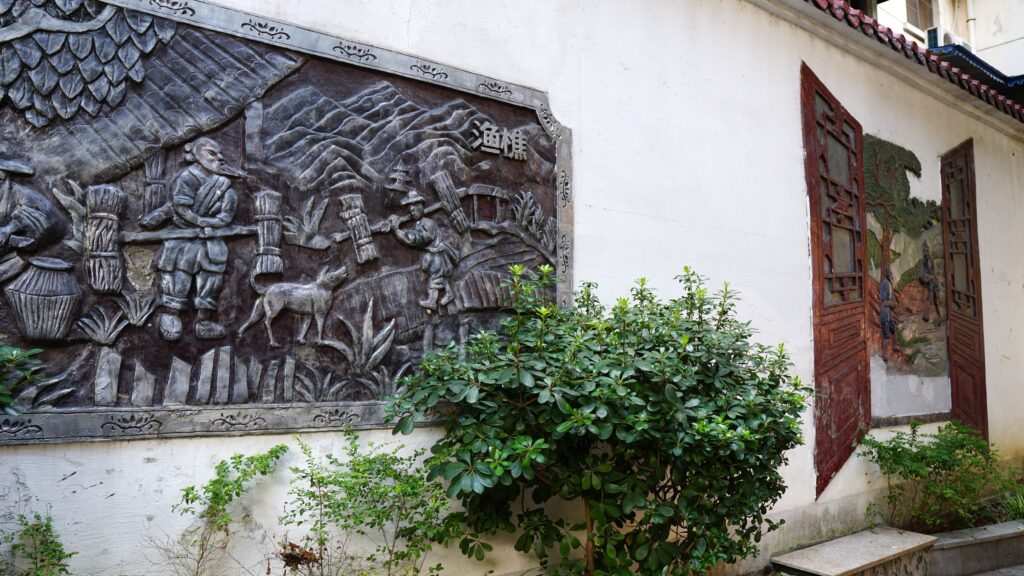
Why “Wuhou Shrine”?
The name honors Zhuge Liang, the brilliant strategist and statesman of Shu Han, who was posthumously titled “Wuhou” (Marquis of Wu). After his death, this shrine was built to commemorate his loyalty, wisdom, and contributions to the state.
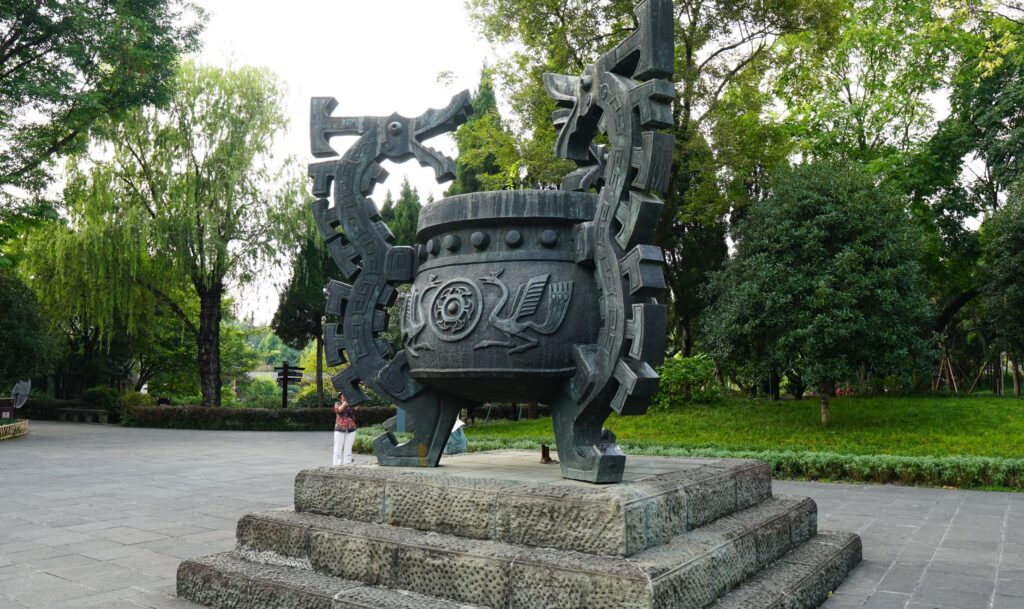
Unlike most ancestral temples in China, the Wuhou shrine shares its grounds with its emperor, Liu Bei. Here, the ruler and his most trusted minister are worshipped side by side—a rare arrangement in Chinese history, where emperors and officials are normally honored separately in distinct temples or ancestral halls. This unique pairing reflects the deep bond and mutual respect between Liu Bei and Zhuge Liang, a relationship immortalized in both historical texts and folklore.
Should You Go?
If you’re not a Three Kingdoms fan, you might wonder whether this place is worth your time. Well, it depends.
- Crowds: During Chinese holidays, the site gets packed. You’ll lose some of the tranquil, reflective atmosphere—but for many, the spiritual weight of the place still shines through.
- Online vs. Reality: You may have seen a stunning red-walled corridor online. It’s real, and it’s beautiful—but come early or you’ll be photographing a sea of heads.
- Cultural Threshold: The shrine is dense with historical references and literary inscriptions. If you’re unfamiliar with the Three Kingdoms saga, some parts may feel hard to appreciate. But if you’re even a little curious, let this be your guide to making it a meaningful visit.
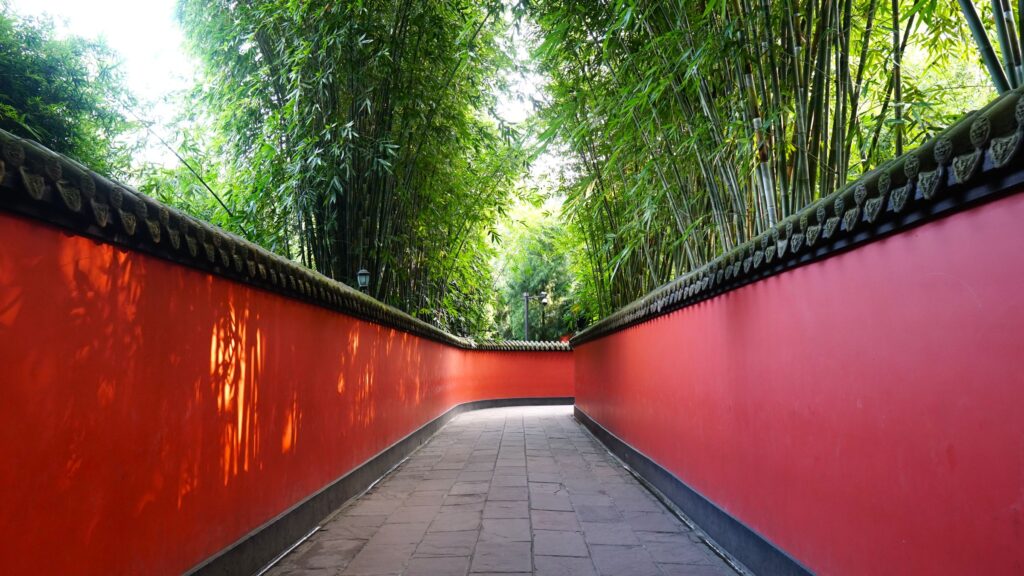
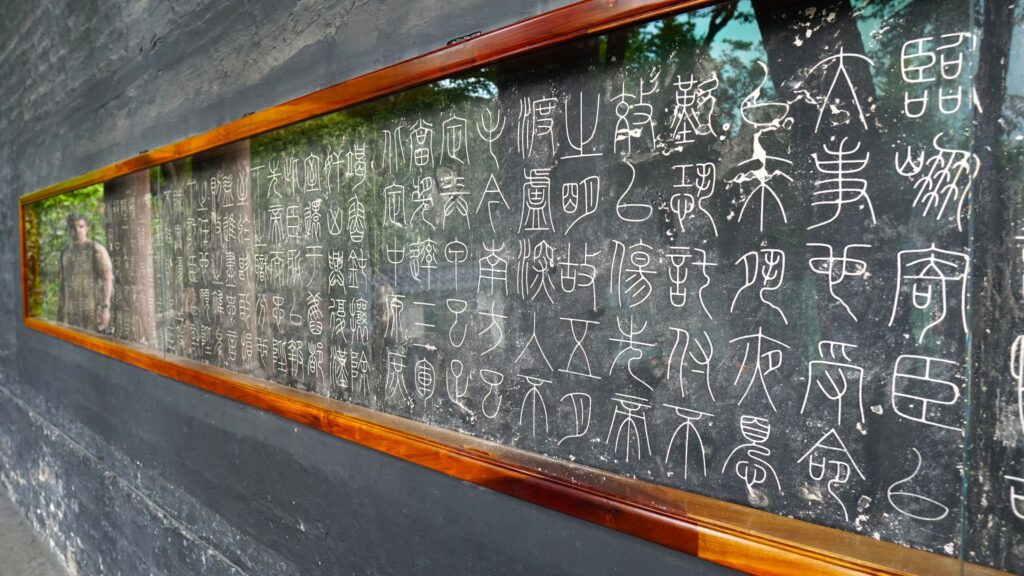
Practical Info
📍 Address: 231 Wuhouci Street (Metro: Gaoshengqiao Station, Exit C)
⏰ Hours: 8:30 AM–6:30 PM (last entry 5:30 PM)
🎫 Ticket: ¥50 (Guided tours ¥20–50, with English options)
Quiet Paths, Loud Legends
The Wuhou Shrine is filled with an air of ancient grandeur. The walkways wind through a lush, green landscape, shaded by bamboo trees and dotted with pavilions and ponds covered with lotus leaves. The whole area feels secluded and peaceful.

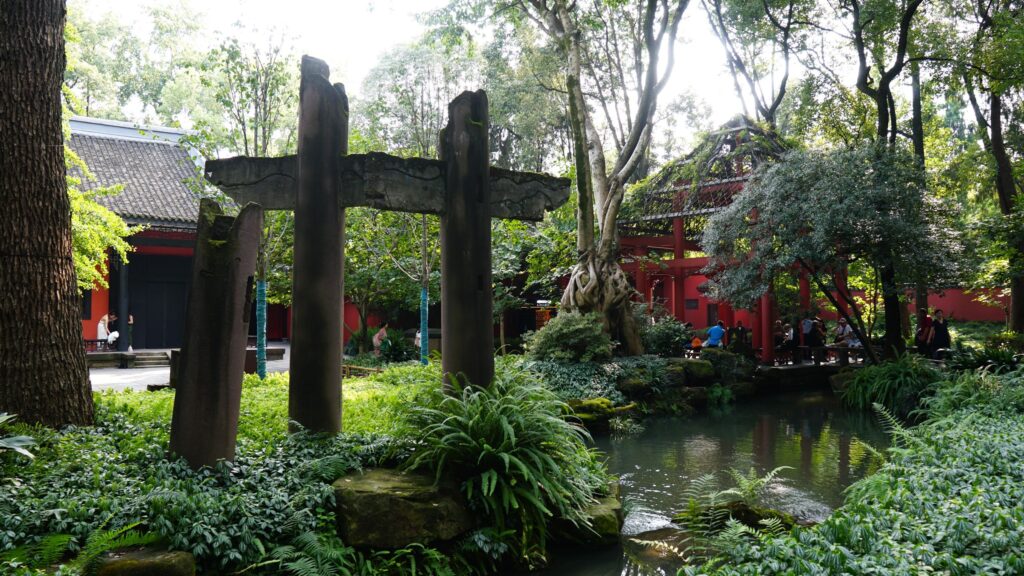
Some buildings house vivid clay statues and relics from the Three Kingdoms period. Some are brightly painted, while others have a time-worn patina.
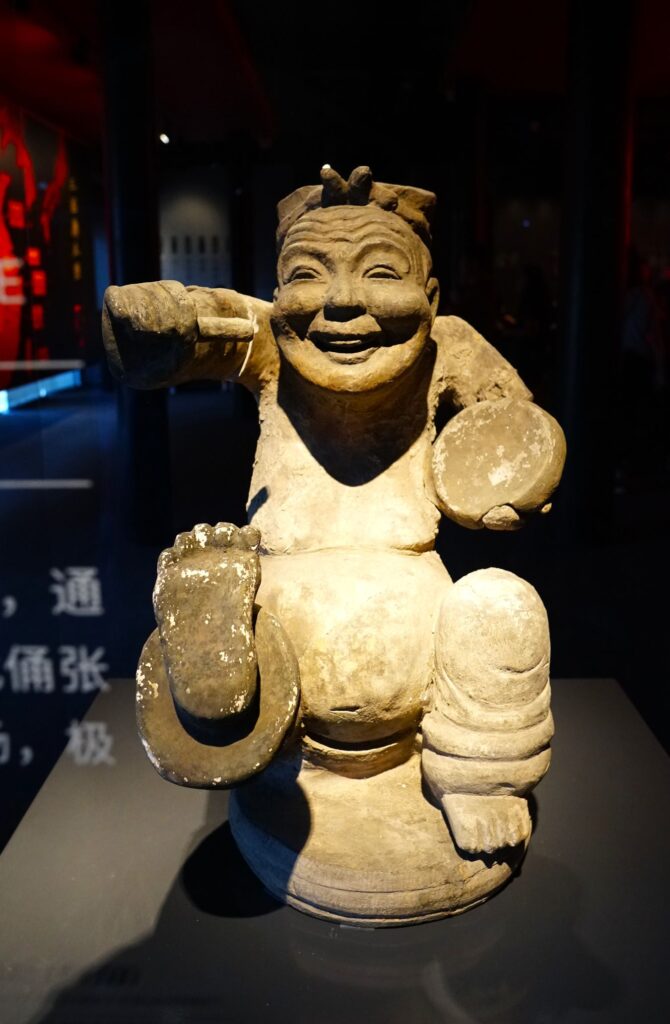
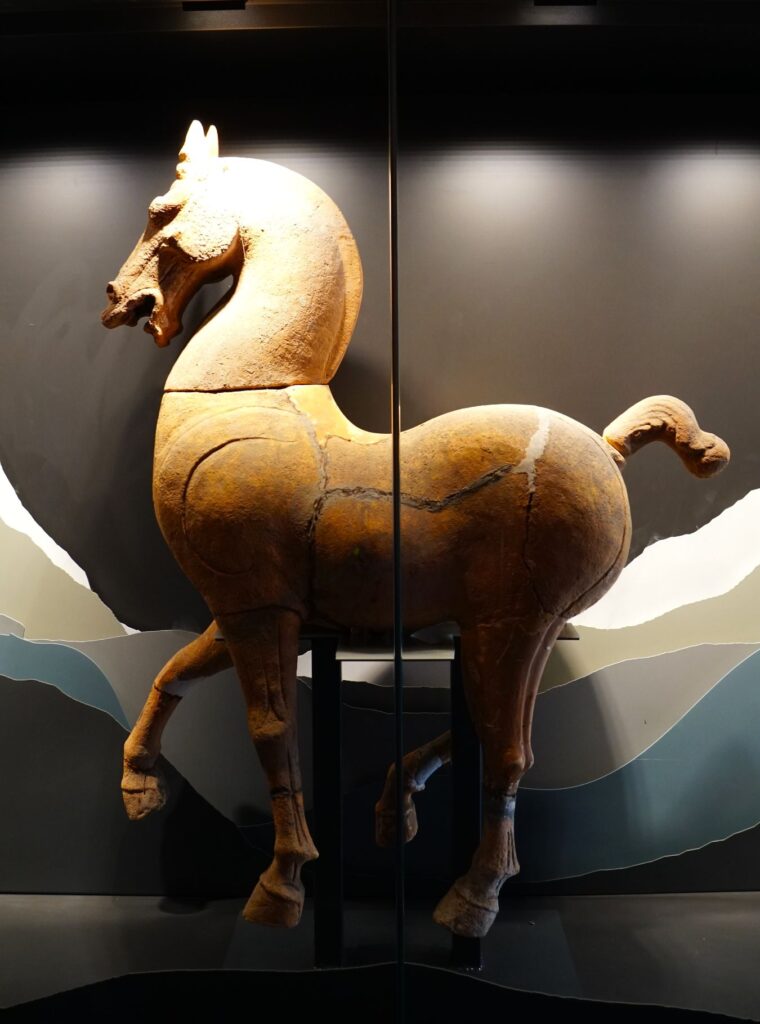
Highlights
The Entrance
Step through the main gate, and you’ll see two ancient stone steles—the Tang Stele and the Ming Stele:
- Tang Stele: Written by Tang Dynasty Prime Minister Wu Yuanheng, it praises Zhuge Liang’s leadership and intellect.
- Ming Stele: Explains why Liu Bei’s ancestral temple was preserved through dynastic changes—a rare phenomenon in Chinese history.
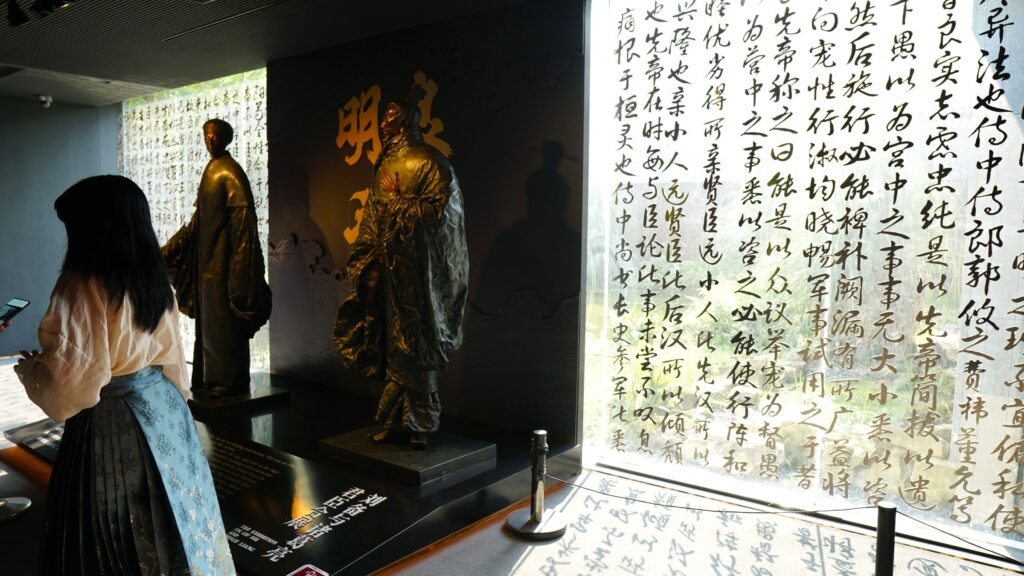
Zhaolie Temple – The Main Hall of Liu Bei
Inside the main hall, Liu Bei sits in the center. Beside him is not his son, Liu Shan, but his grandson, Liu Chen. This is no accident—Liu Shan was removed from the temple due to historical disdain for his surrender to the Wei kingdom.
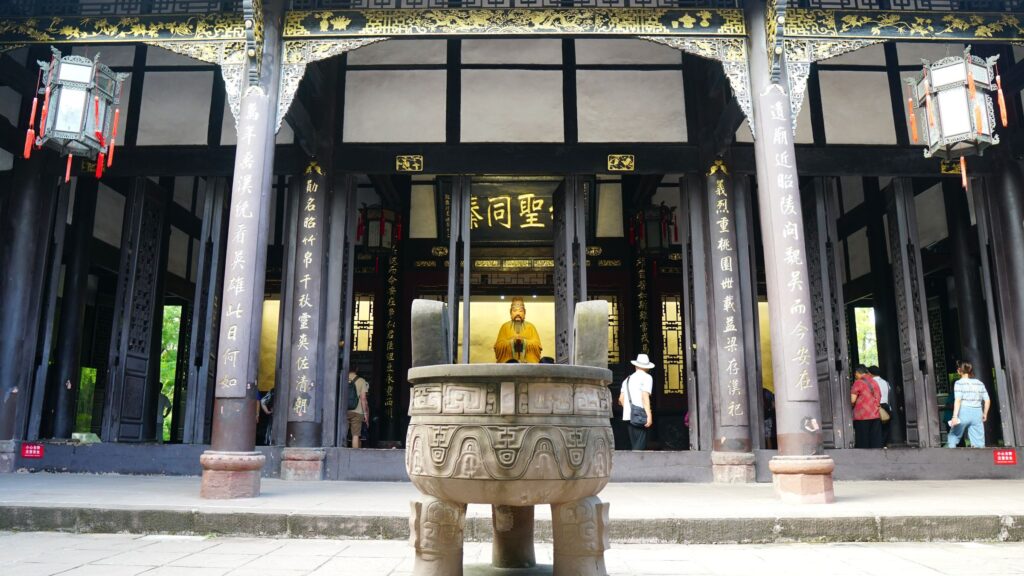
Pay attention to:
- The inscription above the hall: “业绍高光”, meaning “to carry forward the legacy of greatness”.
- The statues of Guan Yu and Zhang Fei flanking Liu Bei. Guan Yu, later venerated as a god of war, and Zhang Fei, known for his deep loyalty and unmatched bravery, stood by Liu Bei not only as military allies, but as sworn brothers. Together, they took the famous “Peach Garden Oath” (桃园三结义), vowing to live and die together while striving to restore peace during the chaotic Three Kingdoms period. Their brotherhood became one of the most enduring symbols of loyalty and unity in Chinese culture—and their statues at Wuhou Shrine still stand shoulder-to-shoulder, as they once did in life and legend.
Hall of Zhuge Liang
A six-building complex surrounds the main shrine to Zhuge Liang. Here you’ll find:
- Famous calligraphy, including the “Psychological Warfare Couplet”, a masterpiece of political wisdom still relevant today.
- The peaceful ambiance of bamboo groves, echoing Zhuge Liang’s calm and composed nature.
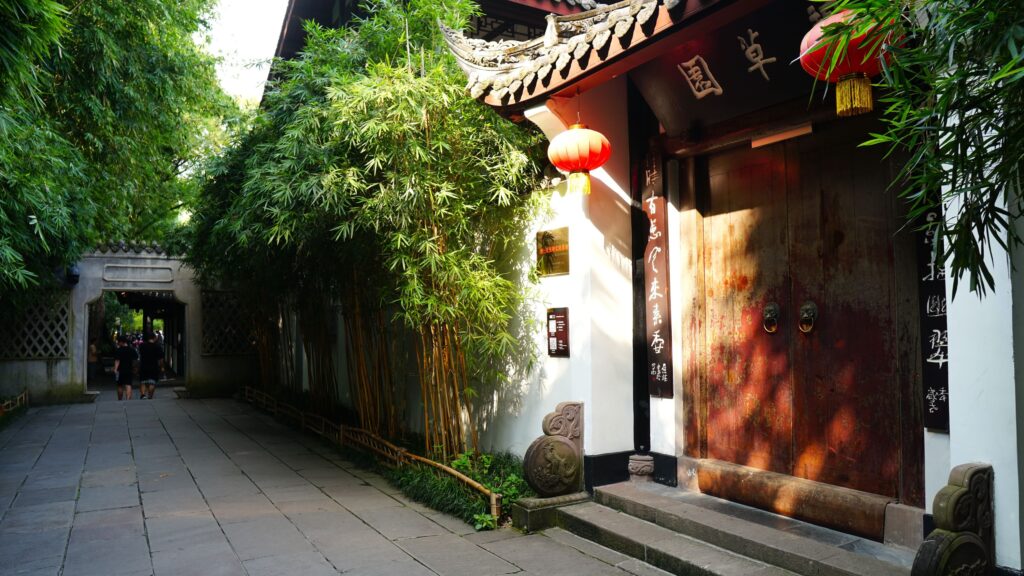
The Corridor of Ministers and Generals
Lining this gallery are 28 clay sculptures of Shu Han’s most notable civil and military figures, along with a full carving of Zhuge Liang’s “Chu Shi Biao” (出师表), his memorial to the emperor before going to war—a 1800-year-old document every Chinese student has likely memorized.
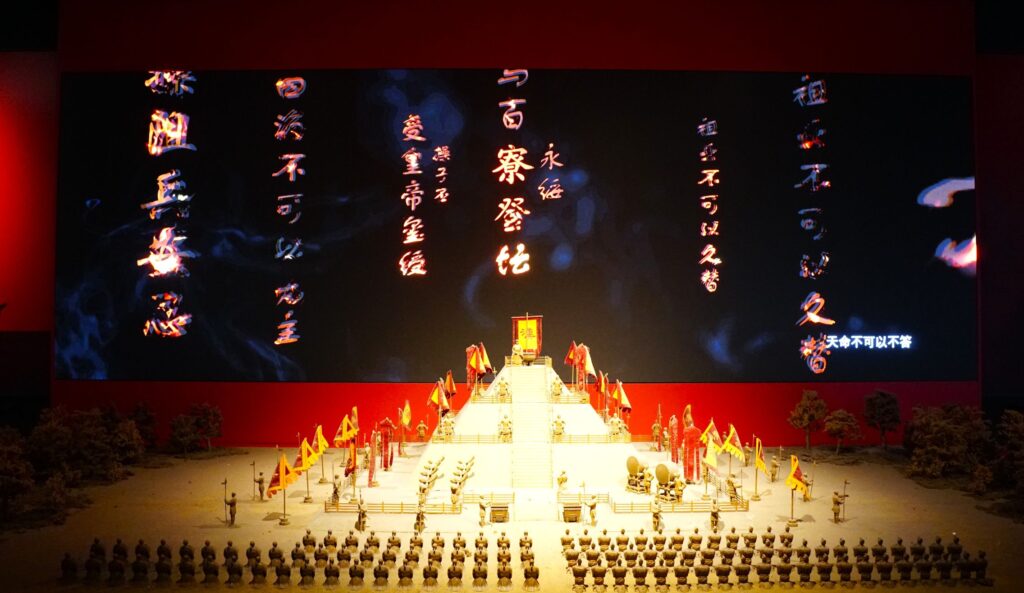
It’s strategic manifesto, as well as a heartfelt declaration of unwavering loyalty. In it, Zhuge Liang lays out his tactical advice for restoring the state and pledges to exhaust himself in service to his ruler and the people, no matter the cost.
The Red Wall Corridor – A viral photo spot where crimson walls frame emerald bamboo.
Pro tip: go before 9 AM to snap that serene, crowd-free shot. We even spotted a few ladies in flowing hanfu.

Huiling Mausoleum – The Resting Place of Liu Bei
Walk past the red walls, you’ll arrive at Huiling, the tomb of Liu Bei and his two wives—Lady Gan and Lady Wu.
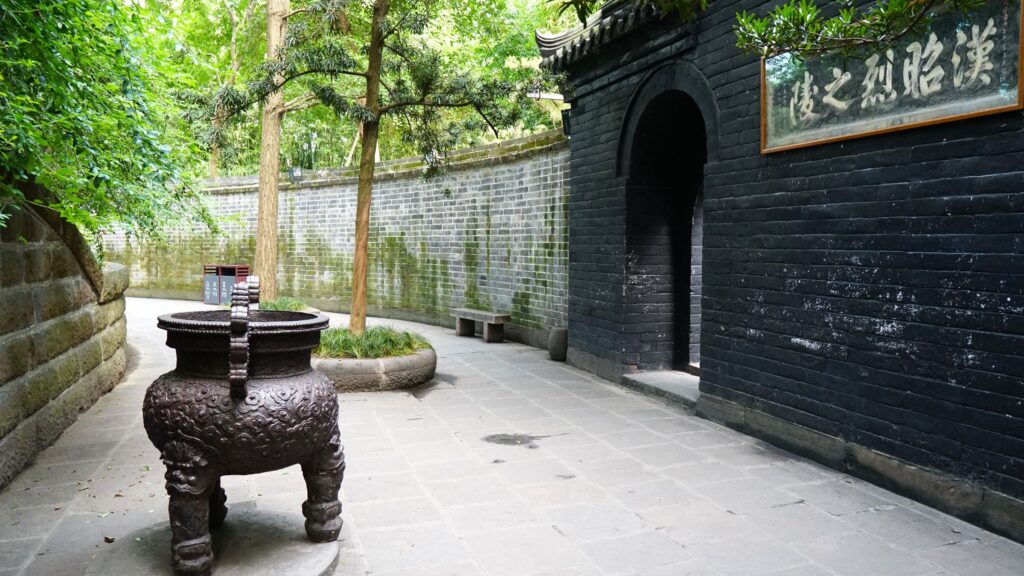
Two other places not to be missed when in Chengdu are Kuanzhai Alley and People’s Park– two spots that beautifully capture the city’s traditional culture and laid-back lifestyle.
Kuanzhai Alley
Built during Emperor Kangxi’s reign (1661-1722), this is one of Chengdu’s last well-preserved Qing Dynasty neighborhoods. The area consists of three parallel lanes:
- Wide Alley (Kuan Xiangzi) – The most bustling main street
- Narrow Alley (Zhai Xiangzi) – More intimate with boutique courtyards
- Well Alley (Jing Xiangzi) – The quietest alley, with artistic installations
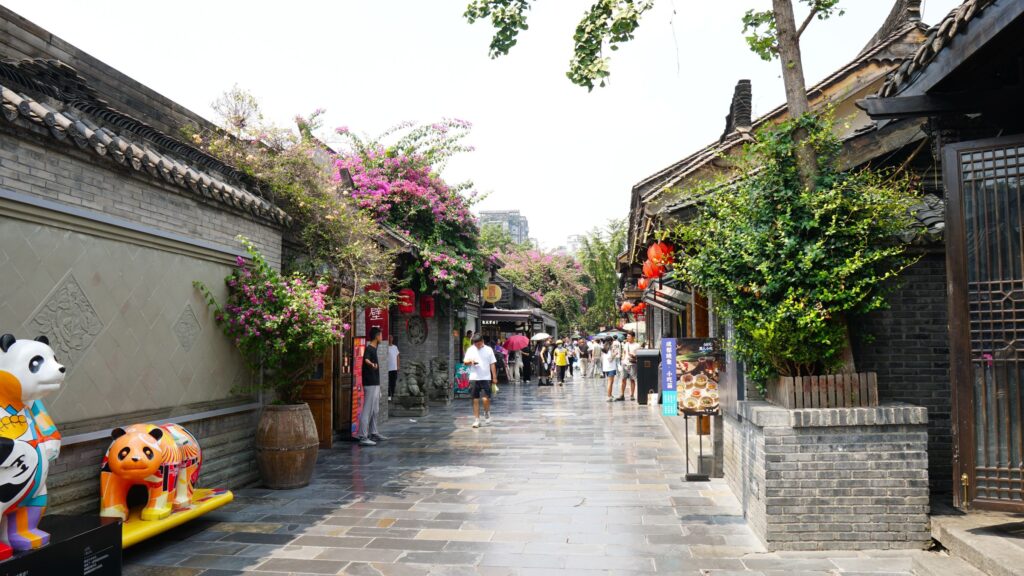
Practical Tips
- Time to visit: 2-3 hours is usually enough (mornings or evenings for less crowds)
- Getting here: Super easy via Metro Line 4 (Kuanzhai Alley/Kuanzhai Xiangzi Station)
- Spending: Kuanzhai food is pricier – snack lightly and save meals for local alleys
Architectural Wonder
The architecture style of Kuanzhai Alley is mostly traditional Sichuan courtyards, with blue-grey brick, tile facades, and stone paved streets. From the grand archways and carved windows to the floral wall skirts, it all has a distinctly ancient Sichuan look. A highlight is the “Kai Lu” (恺庐) in Kuan Alley, with its curved arch and intricate wooden carvings, representing the artistry of traditional Sichuan craftsmanship.
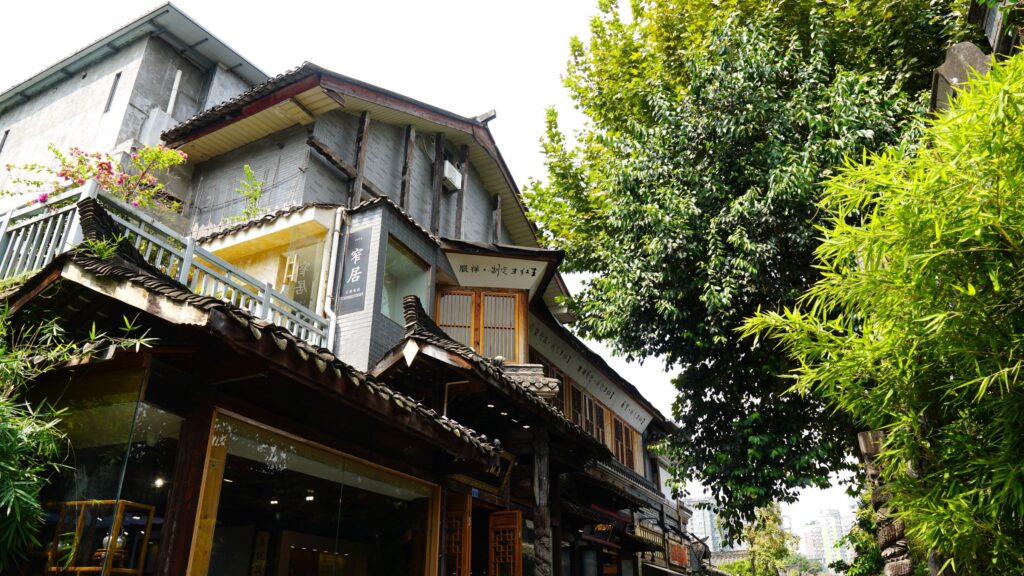
A Foodie’s Paradise
The area is teeming with sweet treats and famous Sichuan snacks. You’ll see panda-themed everything, such as “Bingfen” (冰粉), a traditional jelly-like dessert made from plant starch and served cold, topped with a variety of toppings such as fruit, peanuts, and sugar syrup.
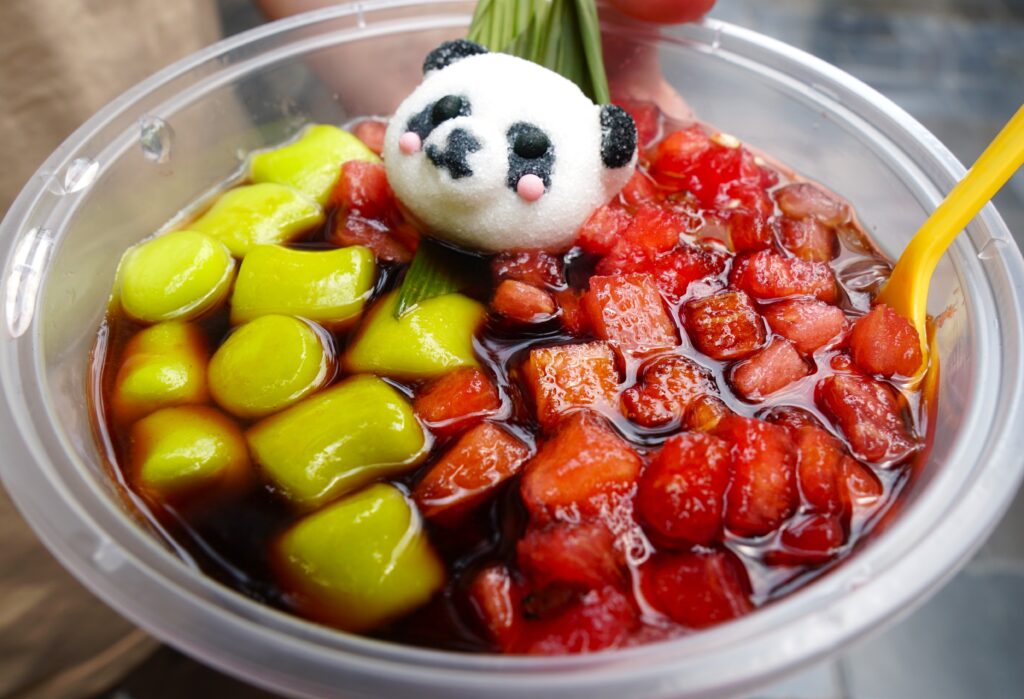
You’ll also find ice cream with a similar playful deco. However, be aware that prices can be on the higher side, as it’s a popular tourist spot.
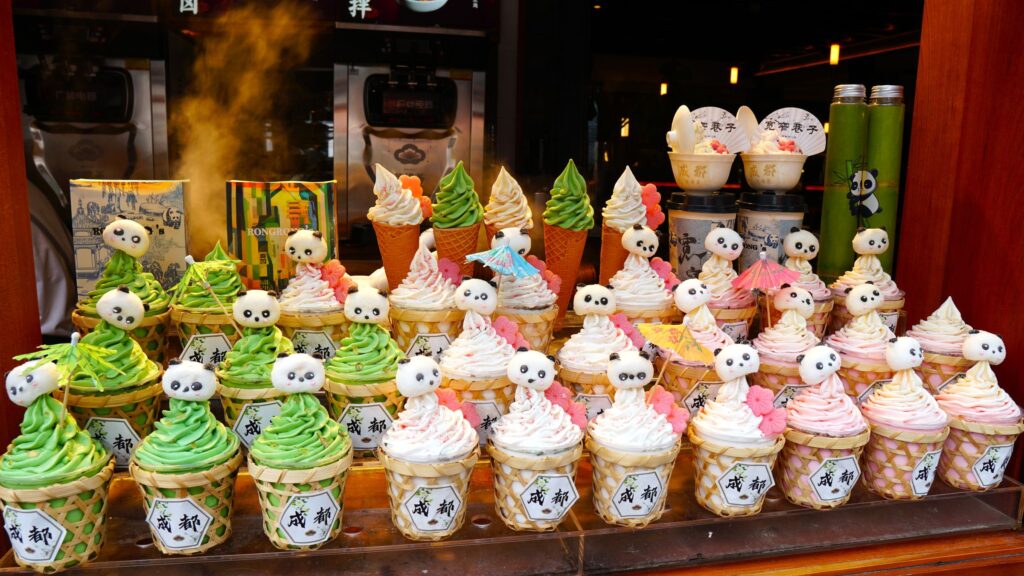
Must Experience
Beyond food and architecture, Kuanzhai Alley lets you dive deeper into Sichuan’s traditional culture. You can try:
- Face-Changing Performances 变脸🎬(From 0:23), where Sichuan opera artists magically swap colorful masks in the blink of an eye – the secrets behind this ancient art form are closely guarded!
- Chengdu Ear Cleaning 采耳, a famous centuries-old Chengdu hygiene practice and local tradition, where masters use special tools for that oddly satisfying tingly clean
- Nighttime Romance, when red lanterns glow against ancient walls after dark
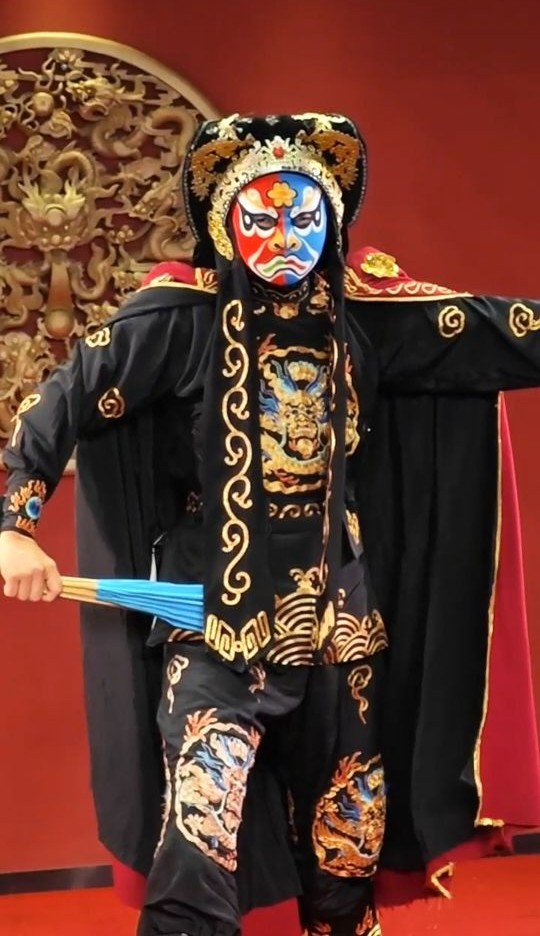
Kuanzhai Alley is where northern Chinese hutong culture meets western Sichuan architectural styles – a unique fusion not found elsewhere.
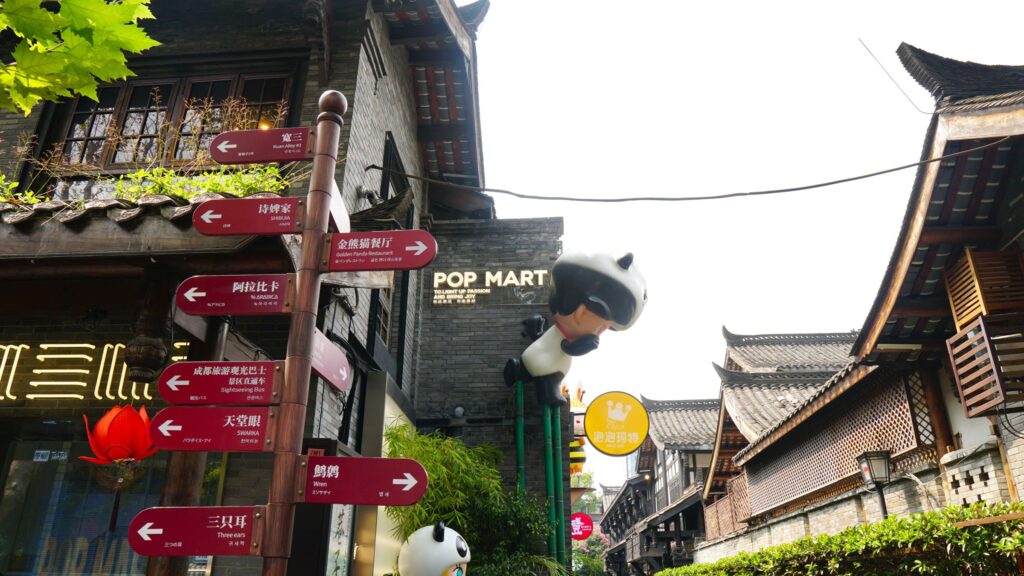
As you walk through, you can feel the charm accumulated over three centuries. Immerse yourself in its historical evolution, explore creative markets, and browse the retro stalls – it’s a great place to leisurely wander.
People’s Park
After exploring Kuanzhai Alley, just a 15-minute walk or quick metro ride (600m from Metro Line 2, Exit D), you’ll arrive at People’s Park – the ultimate showcase of Chengdu’s legendary laid-back lifestyle.
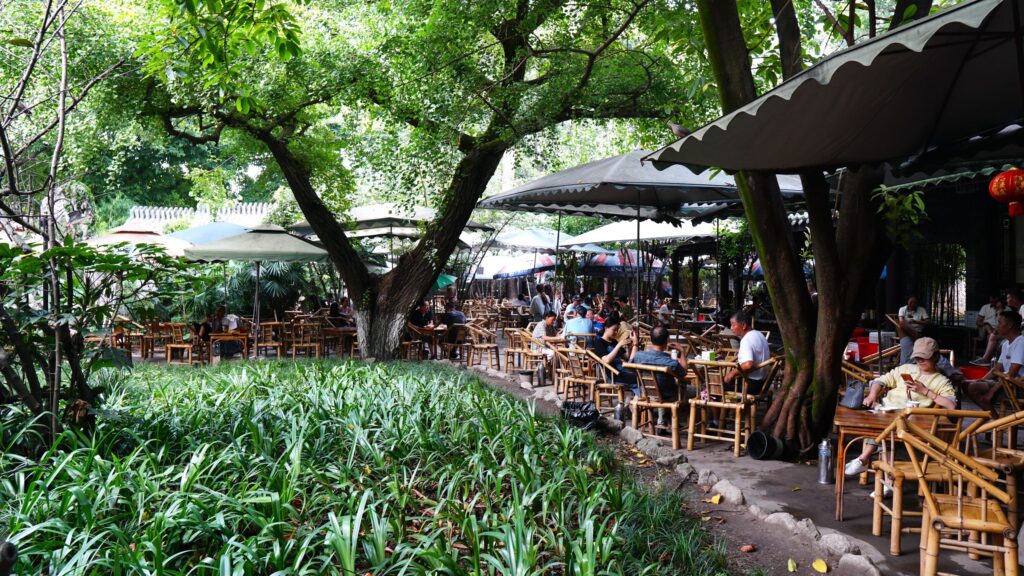
If you come here early in the morning, you’ll catch the park at its liveliest, with locals practicing Tai Chi or sword dancing. As we wander, we spot elderly using giant calligraphy brushes dipped in water to write beautiful characters on the ground🎬(from 0:35). The temporary art fades in minutes, but the skill and fluid movements are mesmerizing to watch.
We also come across a Matchmaking Corner where parents post “resume walls” detailing their children’s age, occupation, and personality traits. Red papers for daughters, blue for sons – each one a sincere attempt to find potential matches for their kids.
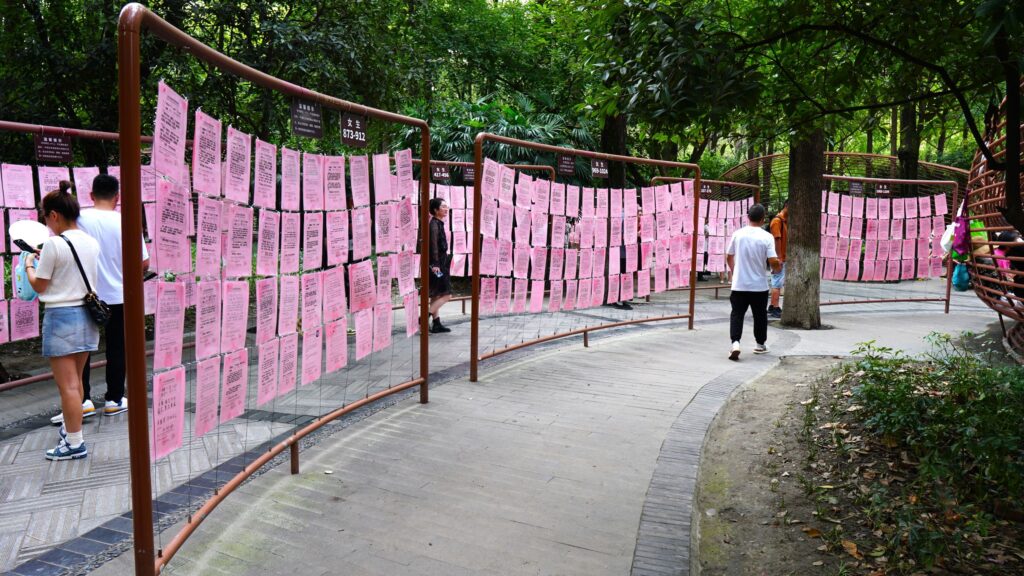
The vegetation here grows with almost tropical enthusiasm. It’s as if you’ve entered a natural air-conditioned space amidst the sweltering Chengdu summer.
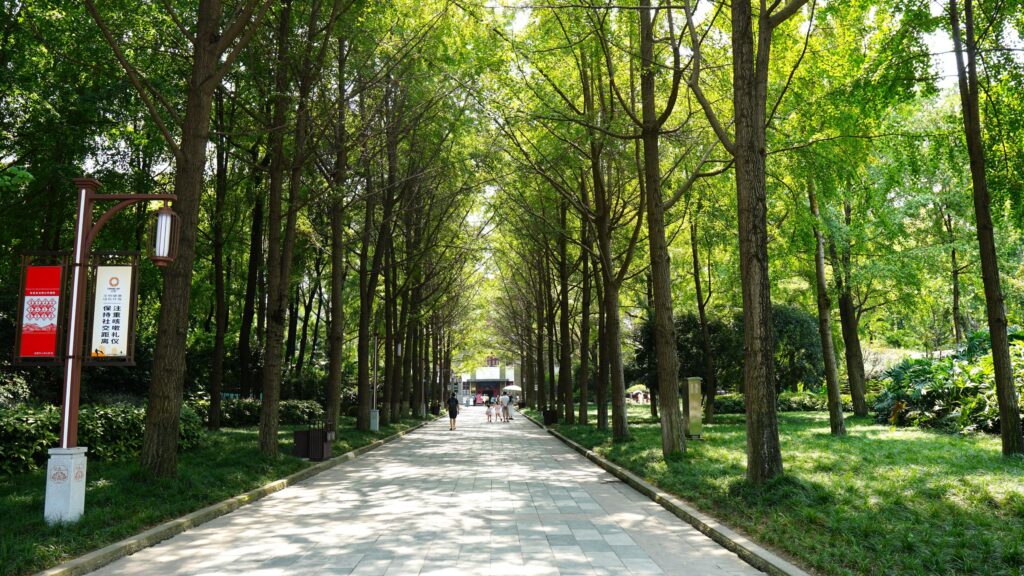
This cooling effect is no accident – the park’s 1911 designers intentionally planted hundreds of shade trees, creating what locals call “the green lung of the city.” Even when temperatures hit 35°C outside, under these leafy giants it’s always a comfortable 5-8 degrees cooler.
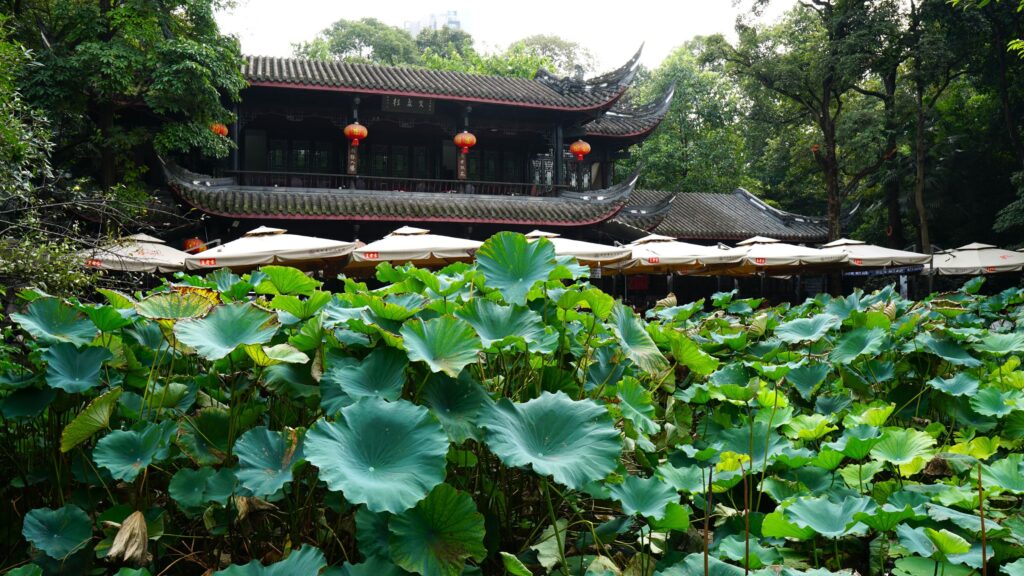
The air is thick with the scent of greenery – fresh, and oxygen-rich. The path is filled with dappled light, rustling leaves, and emerald lotus leaves glistening with moisture.
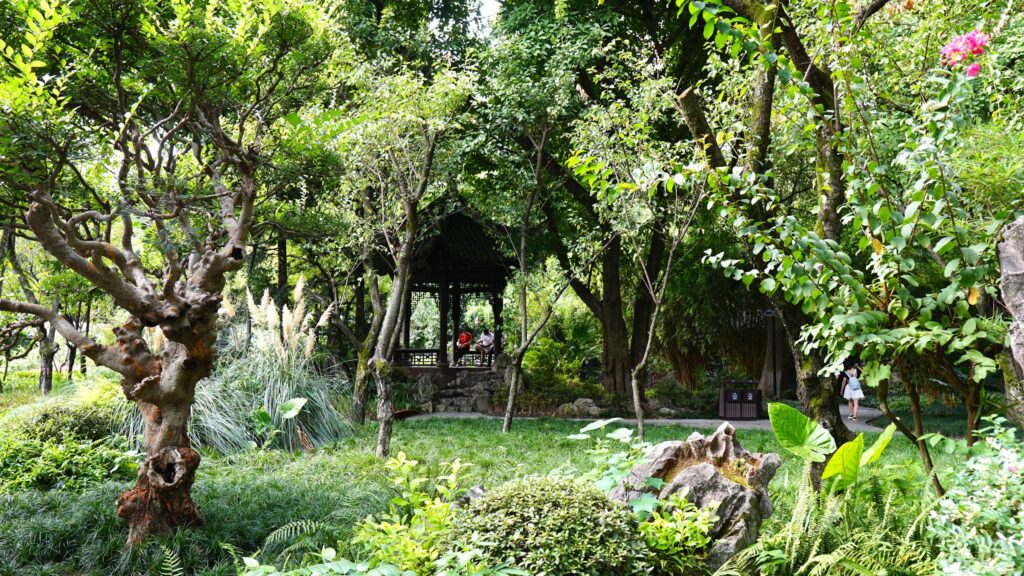
Beneath the pavilions, locals gather, chatting softly or fanning themselves in peaceful contentment. Along the covered corridors, a few lose themselves in a book, calm and absorbed.
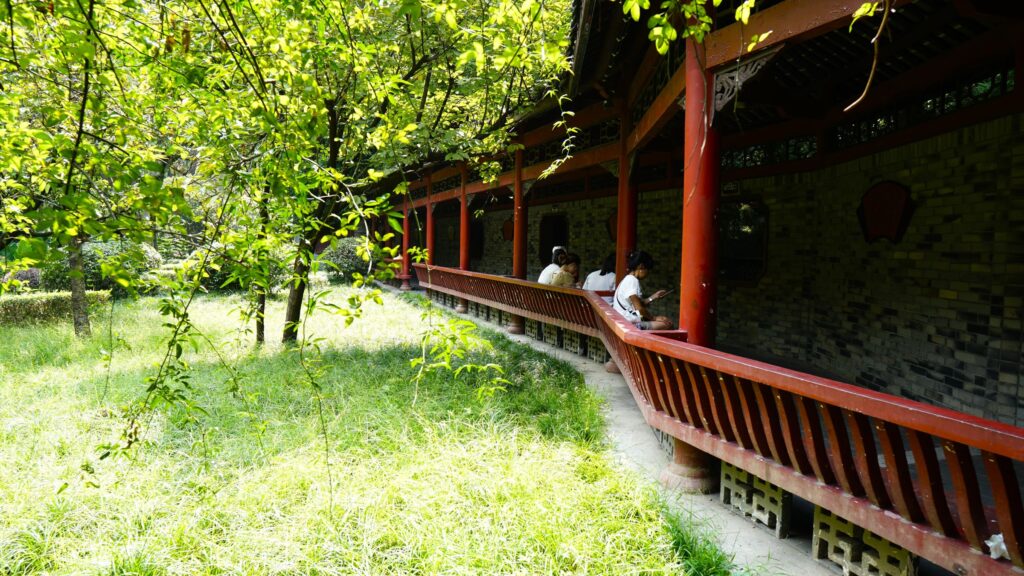
If you arrive in the afternoon, you can:
- Paddle a boat on the willow-fringed lake, gliding through the ripples.
- Stroll the shaded paths, enjoying the soft murmur of the nature.
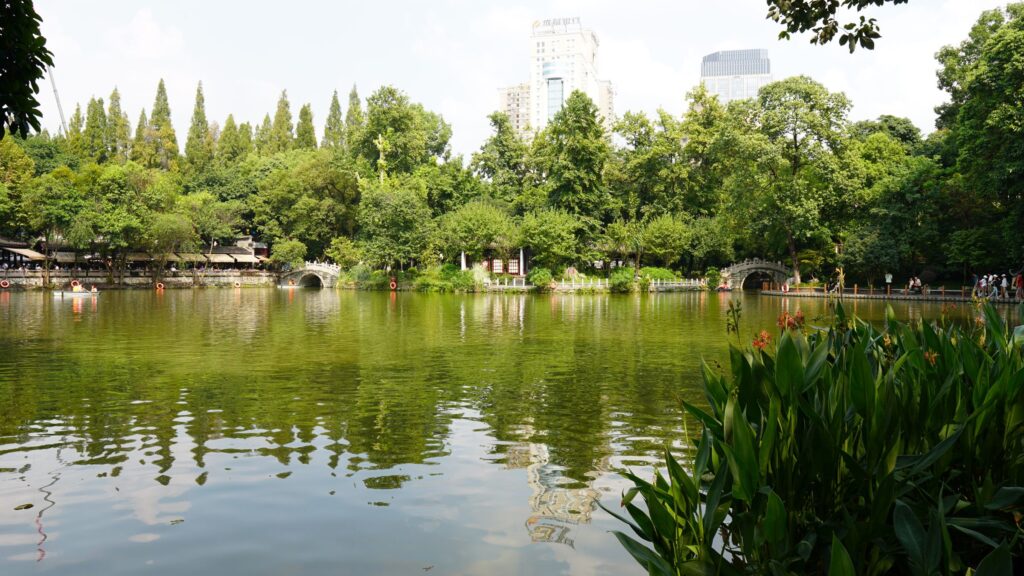
Highlights:
Penjing Garden (盆趣园):
Ranked among Sichuan’s Top 10 Gardens, this oasis featuring exquisite bonsai displays, and artificial mist rising from the water as gentle music plays from hidden speakers.
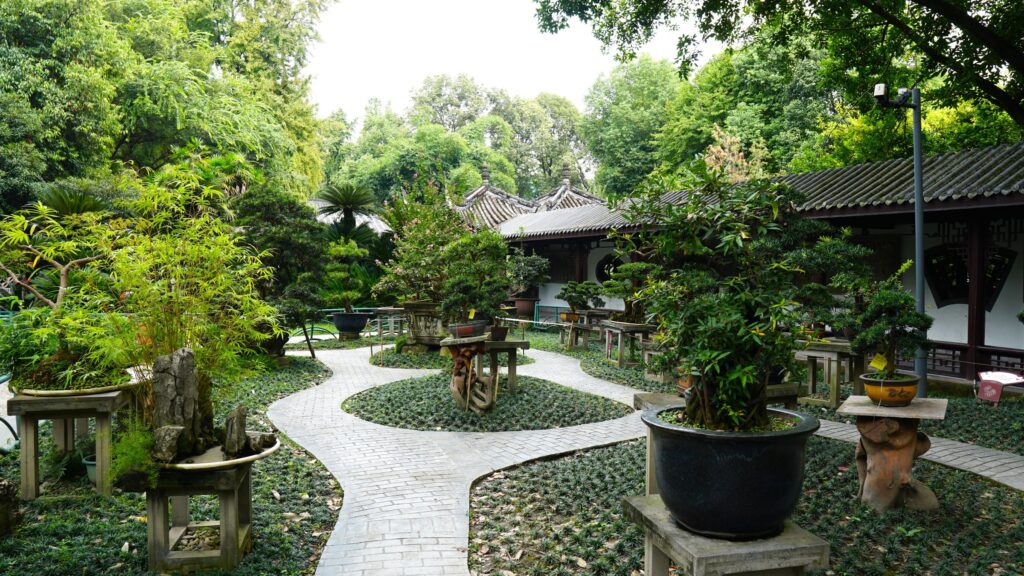
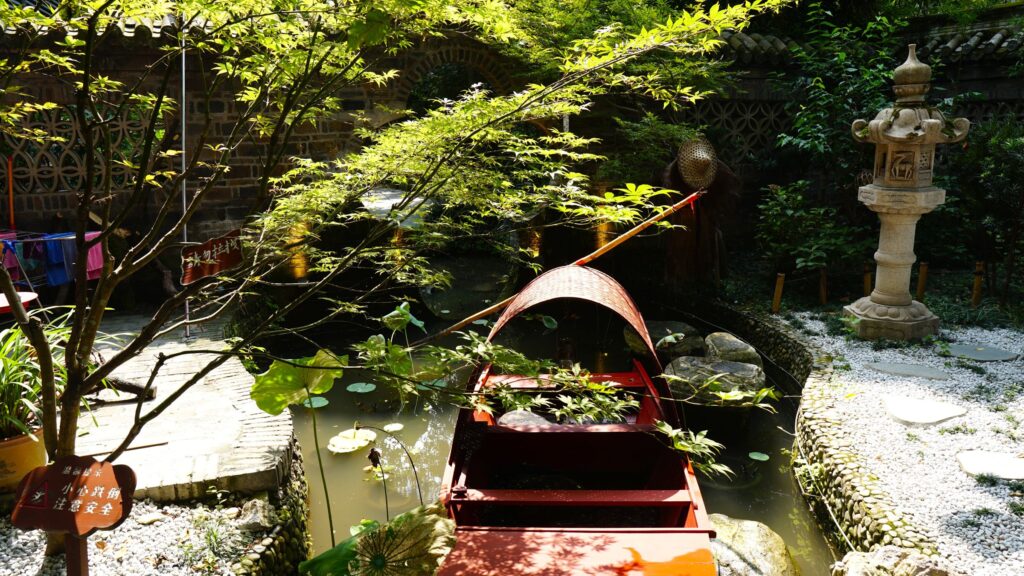
The bridge, the lotus flowers swaying in the mist, it’s like a scene straight out of a Chinese ink painting.

Teahouse:
The most famous teahouse here is Heming Teahouse (鹤鸣茶舍). Established in the early 1920s, it is one of the oldest teahouses in Chengdu. You can watch “kung fu tea” pouring ritual🎬(from 0:29), where tea masters use long-spouted kettles to pour hot water into tiny teacups with almost acrobatic movements.
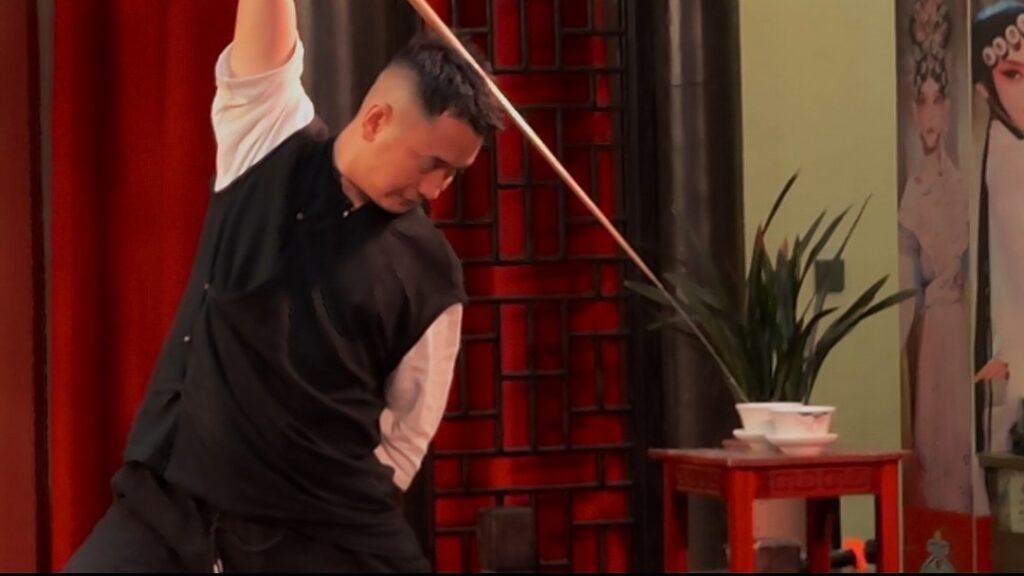
This place is usually packed and the prices are on the higher end. If you don’t want to stick to the iconic Heming, the park also has many other local alternatives.
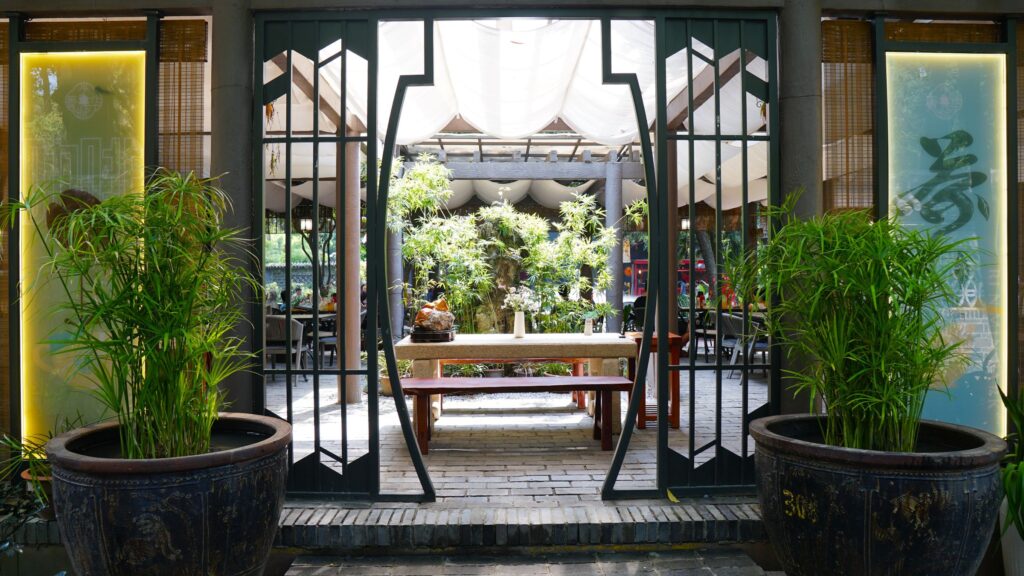
At some, you can sip tea while enjoying live traditional performances🎬, such as a melodic plucking of the guqin – a traditional Chinese instrument that sets the perfect backdrop for an afternoon tea relaxation.

WWII Air-Raid Shelter:
A former wartime bunker now transformed into a small museum. It features exhibits about the Chinese War of Resistance against Japan and the Sichuan Railway Protection Movement (exhibits only available in Chinese).
Xinhai Baolu Memorial Square:
Honors martyrs in the 1911 Railway Protection Movement, which sparked the Xinhai Revolution and ultimately led to the fall of the Qing Dynasty.

This park is said to be where Chengdu’s soul resides. Come watch, participate, and understand why locals say: “In Chengdu, we don’t kill time… we savor it.”
There’s no better way to dive into Chengdu’s culinary soul than with a steaming, bubbling Sichuan hotpot. There are many local hotpot places in the alleys of Chengdu. We chose Yu Shaoxia Hotpot (渝少侠火锅), a popular local chain.
The moment you sit down, the staff will serve you a complimentary cup of tea.
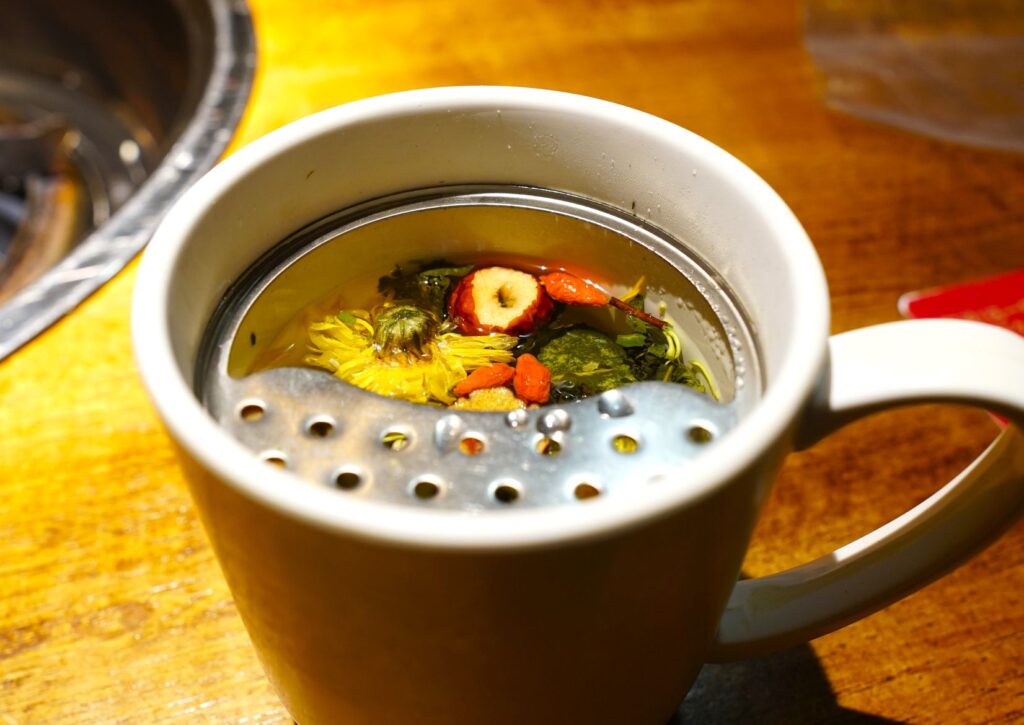
We went for the classic yin-yang guo, which has two contrasting broths:
🔥 Spicy Beef Tallow (牛油): A deep, crimson pool of Sichuan’s signature málà (numbing-spicy) punch, loaded with chili and Sichuan peppercorns. One sip and your lips tingle.
🍄 Mushroom (菌菇): The soothing, earthy counterbalance – perfect for when the spice becomes too exhilarating.

The broths arrive made-to-order, with hot water poured tableside for maximum freshness.
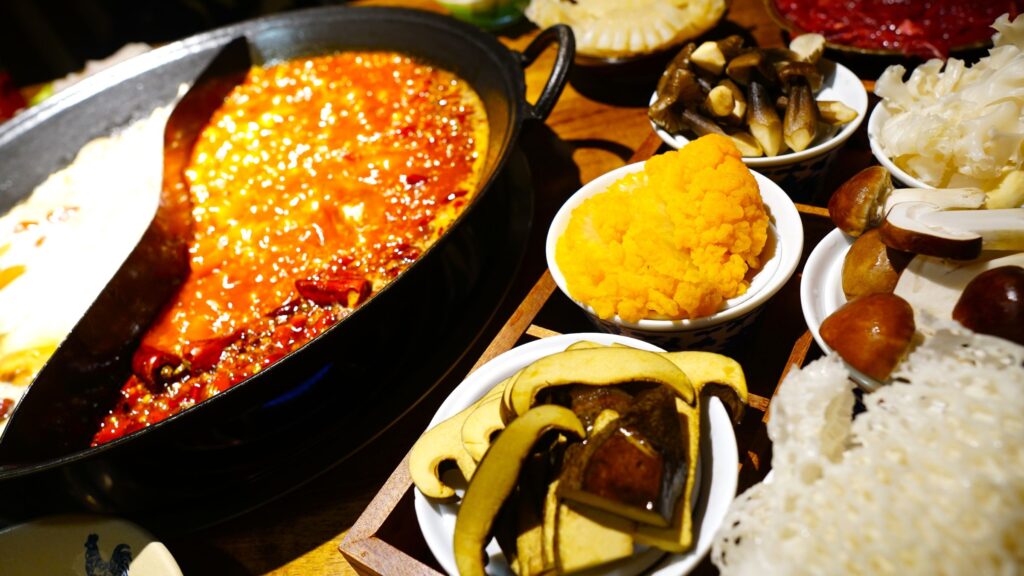
Here’s what we ordered:
🥩 Beef Slices: Thin and nicely marbled, they cook in seconds into the spicy broth, emerging silky and rich.
🐮 Beef Tendon: Slow-cooked until it turns jelly-soft, with a satisfying bounce.
🐟 Black Fish Slices (boneless): Delicate, buttery, and perfectly flaky.
🧠 Pork Brain: Yes, really. Poached gently, it becomes creamy and custard-like, with a mild, almost sweet flavor.
🍤 Shrimp Paste: Fresh, smooth, bouncy quenelles that soak up the broths—they’re sweet, briny, and packed with seafood flavor!
🍄 Assorted Mushrooms: Earthy, meaty, nicely complementing the spice with their umami depth.

After the fire came the calm. We ordered a panda milkshake for dessert – light, floral, and mildly sweet, with slippery jelly noodles and matcha chocolate cookie as a cute, delicious finale.
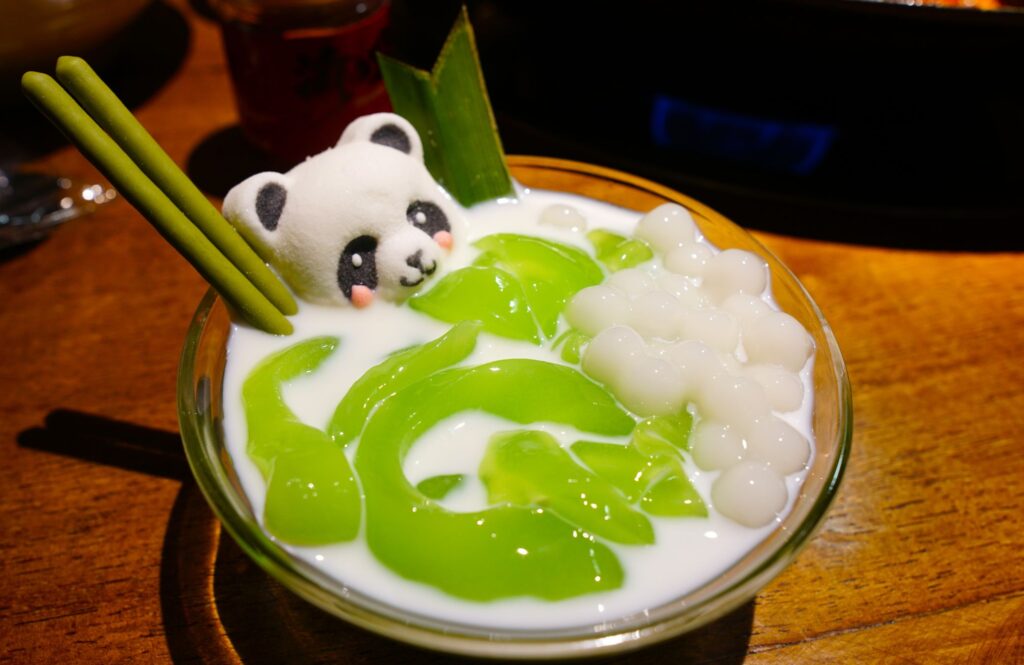
Dip strategy:
At the sauce bar, you can customize your heat-defense system:
Classic Mix: Sesame paste + garlic + cilantro + scallions—pungent, aromatic and creamy, nutty shield against the fiery málà spices.
Pro Move: A sesame oil + garlic + scallion dip cuts through the grease and washes away excess oil for a lighter taste.
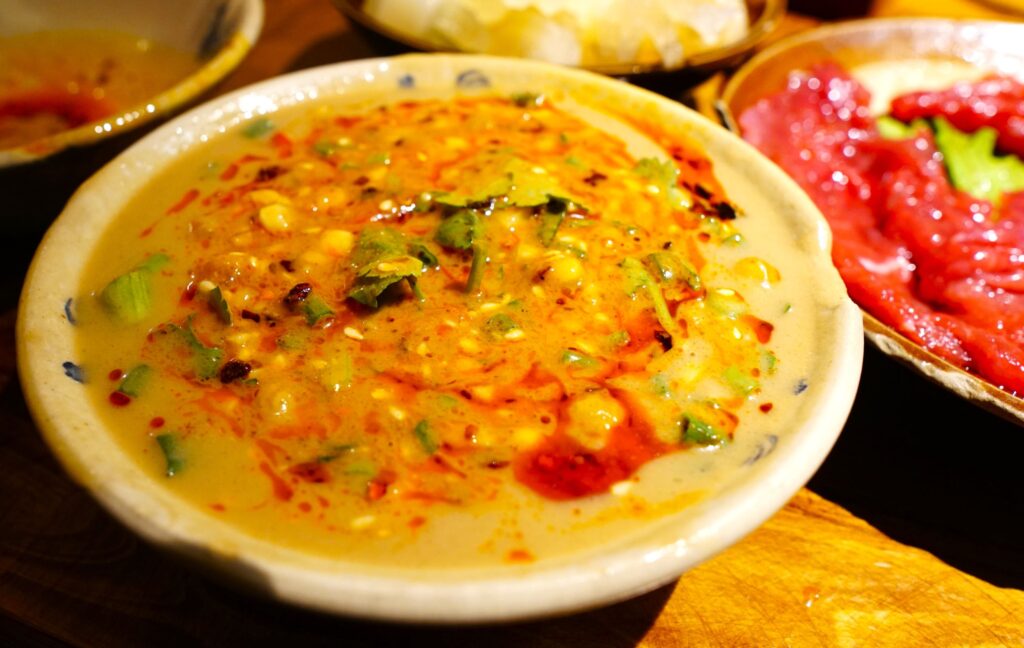
The steam, the sizzle, and the flame – get ready to embrace the sweaty chaos! It’s messy, euphoric, and utterly Chengdu.

Next up, we’re off to Leshan — Sichuan’s best-kept food secret! It’s lesser known, but some locals swear it has even better bites than Chengdu. Beyond its culinary scene, Leshan is also home to UNESCO World Heritage Site, the 71-meter-tall Giant Buddha carved into a riverside cliff. So, stay tuned – as Leshan’s giant flavors (and giant Buddha) are calling!
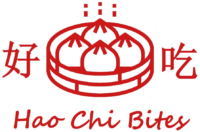
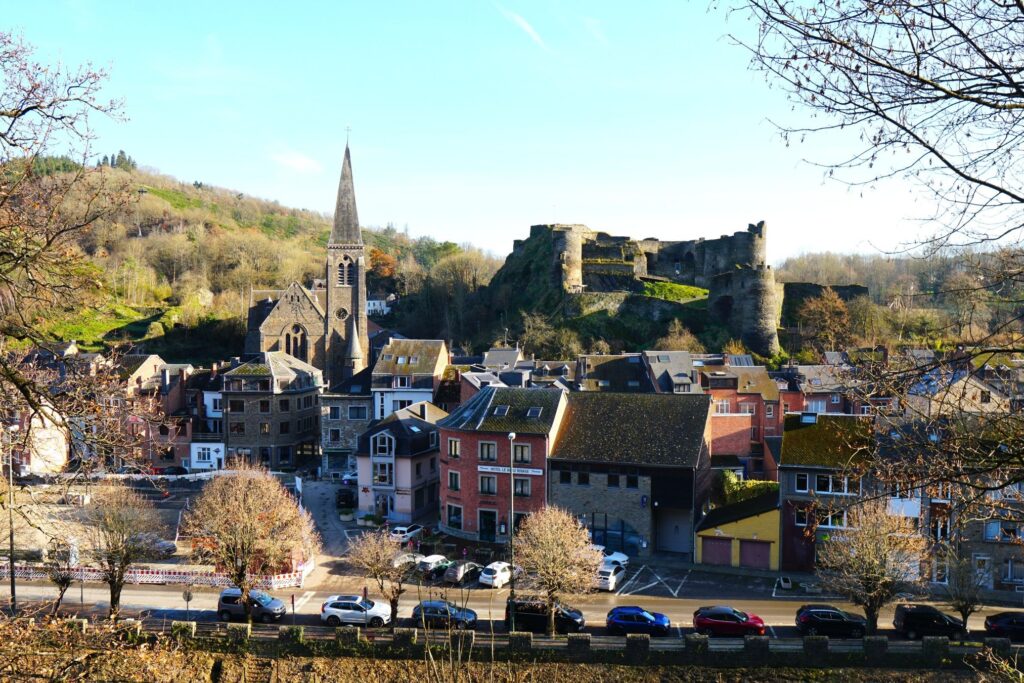
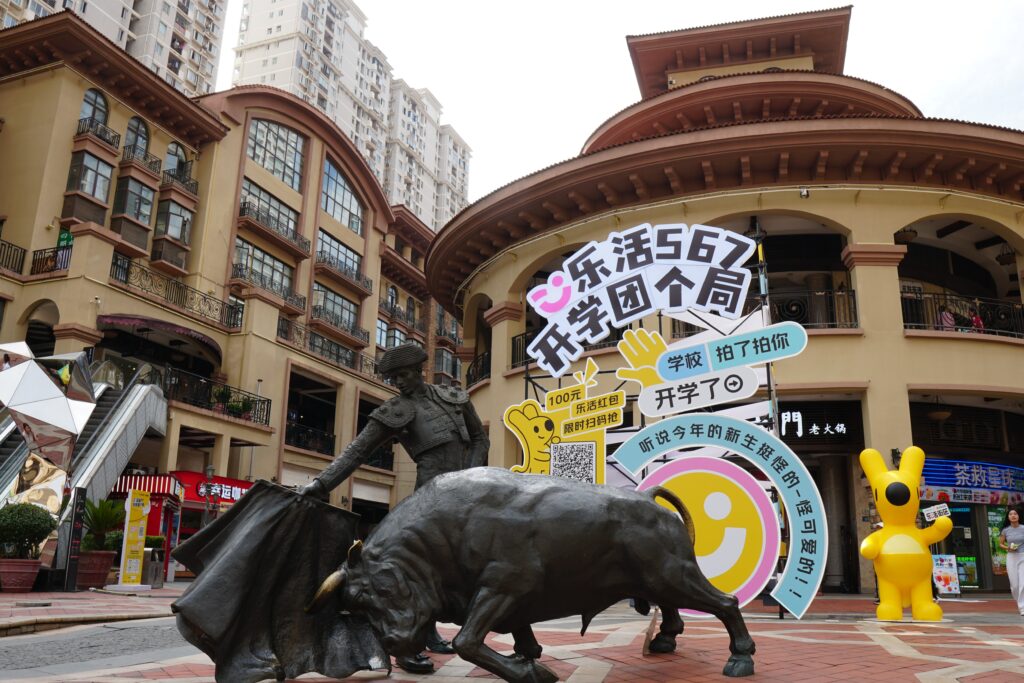
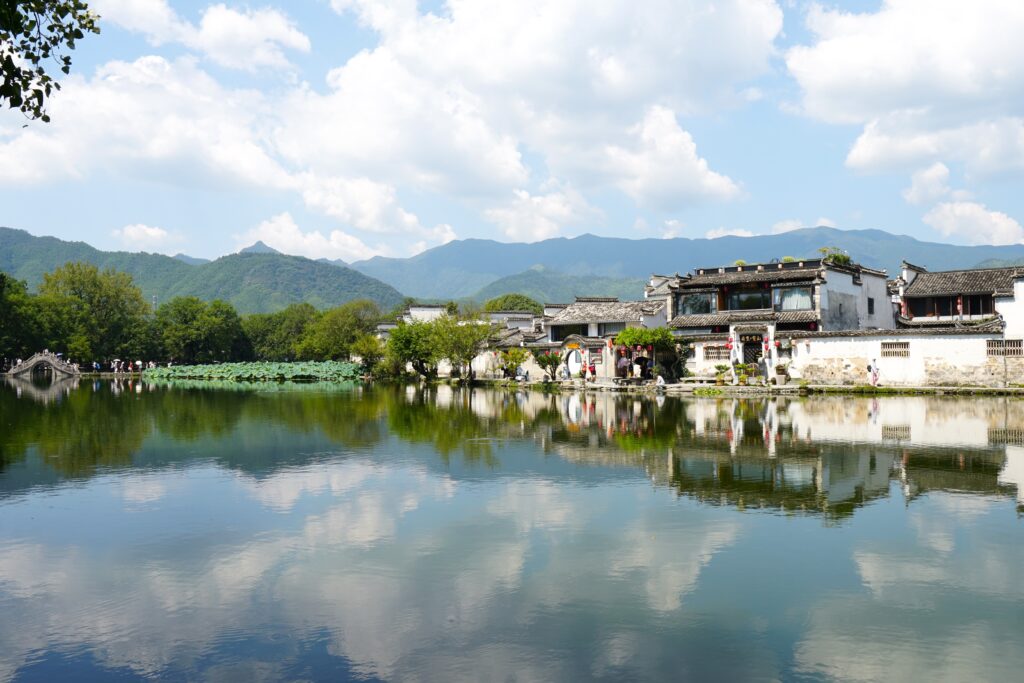
Good to know they have non-spicy hot pot too. I heard this place is known for spicy food, so I was wondering how you could take care of yourself here if you can’t handle spicy food.
Hello thanks for sharing! Do you also do tours? I only have one day in Chengdu. My hotel is at Tianfu Square. Is this ok, if I go: Kuanzhai alley -> Wuhou Temple -> Jili Street -> Chuxi Road -> IFS -> Taikoo Li
Hi Connie, no we don’t do tours, but based on our experience, your plan should be doable, but quite packed for one day.
Kuanzhai Alley and Wuhou Temple are fairly close, so starting there makes sense.
Jinli Street is right next to Wuhou Temple.
From there, Chunxi Road, IFS, and Taikoo Li are all in the same area, and you can easily walk between them.
Amazing photos! Thanks for the update!
Hey, just wanted to say thanks for your update. I’m not sure if I’ll ever get the chance to visit Chengdu, but I really enjoyed reading your article and learning about the culture.
Chengdu looks so green! I love it! It’s definitely at the top of my list for my next trip to China.
I love your photos! The greenery, the people, and the architecture—everything looks beautiful. Do people usually wear traditional Chinese clothing in daily life? I noticed a few in your pictures wearing them.
Thanks so much! And about the traditional clothes — no, it’s not super common for people to wear them in daily life. But sometimes, for example at tourist spots for fun photos or at festivals, people love to dress up in hanfu or qipao!
I heard China is so crowded that people can barely walk, but it doesn’t seem like that in your photos. It looks like a beautiful place, I’d like to visit if I get the chance.
Thanks for sharing the beautiful photos! The red wall with bamboo is so beautiful. I never knew red could be so calming.
Thanks so much for your post! How is Kung Fu tea priced? Can we order one tea ceremony to share among five guests at one table?
Thanks for your introduction to the Wuhou Shrine. The sense of history is really strong there, and there are barely any English explanations in the scenic area. I’m really interested in the Three Kingdoms culture, but I still find many parts hard to understand…
Your posts really help me a lot to plan my trip to China. Thanks so much for putting together all the info!
The traditional Chinese dress is the most beautiful thing! Looks so ethereal and dreamy.
Wow, thanks for such an informative post! It’s a must-read for anyone planning a trip to Chengdu. I’m looking forward to seeing more of your work.
Those panda desserts are honestly the cutest thing ever!
Qué sensación tan tranquila, me encanta el ambiente en Chengdu.
I wonder how you got those great shots – good job! I went to Kuanzhai Alley, and it was packed with people. The food there was nice, but you can definitely find cheaper, tastier options elsewhere. The tea houses in People’s Park are about five times more expensive than the spots near my hotel. But I guess tea prices vary a lot depending on the type or category.
Just got back from Chengdu—an amazing trip!
Got a ton of requests at the matchmaking corner ‘)
Hi, I just wanted to quickly drop a note that I’ve been following your blog for a few months now. The Chengdu trip looks really interesting, and it’s great to see your latest update after a little break. Please keep it up – I’m really looking forward to your post on Leshan Buddha. Thanks again for your great work, and wishing you all the best with your travels and blog!
Chengdu looks so different now! From the photos, it’s way more modern and cleaner than I remember. I was there 10 years ago, and the streets had a much more local vibe back then.